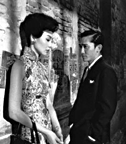
Movie Guru Rating:

Comment
on this review
| |

In The Mood for Love is a mash note to Hong Kong, Hollywood and true romance
by Jesse Fox Mayshark
Wong Kar-Wai's In the Mood for Love is drenched in rain and shadows and ripe colors so deep you could swim in them. The movie is a cigarette haze of romantic iconography, a man and woman sometimes together and sometimes alone, gazing at each other or at themselves (there are mirrors in almost every scene), faces blank but eyes full of longing and regret and the knowledge of unfulfilled promises.
It has a plot, but not much really happens. Mr. Chow and Mrs. Chan, the only names we ever learn for them, are neighbors in a Hong Kong duplex. Through a series of small confirmed suspicions, they learn that their spouses—neither of whom we ever see except from behind—are having an affair with each other. The rest of the movie is about what they do, and don't do, with that knowledge.
Wong Kar-Wai makes movies that are like nothing else on earth (previous American releases include Chungking Express, Fallen Angels and Happy Together). Working without a script and usually only vague ideas of a story, he pares his films down to a cinematic essence. His understanding of his medium is so intuitive, so internalized, that his work always seems both intensely familiar and bracingly new. We've seen all this before, and yet we've never really seen it. As Mrs. Chan says at one point, "People who pay attention notice things." These movies pay attention.
It's difficult to write about Wong, because his films are dense with implication and reference but rarely explicit about anything. On the surface, if a movie as deliberately multi-layered as In the Mood for Love can be said to have a surface, this is a story about desire and denial. Chow and Chan, played with muted sensuality by Hong Kong superstars Tony Leung and Maggie Cheung, first see each other as neighbors, then in accidental meetings in hallways and noodle shops.
Then comes the discovery of their mutual cuckoldry, followed by a long series of conversations. They ask each other, how did the affair between their spouses start? They role-play the possibilities, him standing in for her husband, her standing in for his wife: Would he say this? Would she say that? Their mates are gone on "business trips" in Japan. Mr. Chow and Mrs. Chan begin to see each other every day. She helps him write a martial-arts newspaper serial. Eventually, he rents a hotel room for their writing sessions. But they almost never touch. "We won't be like them," they promise each other.
It goes on in episodic flashes, the film framing them separately and together in doorways and alleyways and windows and all those mirrors. In these lush images, with the camera moving and building erotic tension like a slow dance, Wong and his longtime cinematographer Christopher Doyle repeat and recreate what feels like every grand romantic gesture the cinema has ever made. The visual vocabulary is drawn largely from Hollywood film noir, and it suggests—and in some ways is actually about—how universal that language of rainy nights and lonely desire has become. The images and situations are specific, but they're also instantly recognizable: man smoking cigarette in neon-lit hotel room; woman listening to a ringing phone but not answering it; a ring on a finger on a hand reaching for another hand. In the Mood for Love is a perfect title. The film is an essay in longing—how we express it, how we repress it, how we signify it to each other and the world.
It is also a love letter to Hong Kong. The movie is set in the early 1960s, which is when Wong moved to Hong Kong as a child. Like most of his films, it is fervently aware of its place and time. For reasons both personal and historical, he establishes the moment as the peak of a certain sophistication and hopefulness, before the Cultural Revolution rent China and long before uncertainty about Hong Kong's future led to an exodus from the city. He rhapsodizes the period details, from the modernist wallpaper and furniture and timepieces to Cheung's stunning wardrobe of high-collared dresses. This was Hong Kong as the emergent cultural center of Asia, the place where East didn't meet West so much as reimagine it.
As the story of the two would-be/could-be lovers comes to a close, so does the era. "That period is over," one of the film's occasional inter-titles tells us. "Nothing that belongs to it exists anymore." The final scene takes place in Cambodia. A bit of documentary newsreel shows de Gaulle visiting Prince Sihanouk in a bustling Phnom Penh, and even as Leung plays out his last lovelorn act in the temple of Angkor Wat, we know what's coming just a few years down the road: the Khmer Rouge, Pol Pot, the killing fields. Nothing lasts, the troubles of two little people don't add up to a hill of beans in this crazy world, a kiss is still a kiss, a sigh is just a sigh.
And, Wong's ravishing testimonial affirms, nothing could ever possibly matter more.

April 12, 2001 * Vol. 11, No. 15
© 2000 Metro Pulse
|